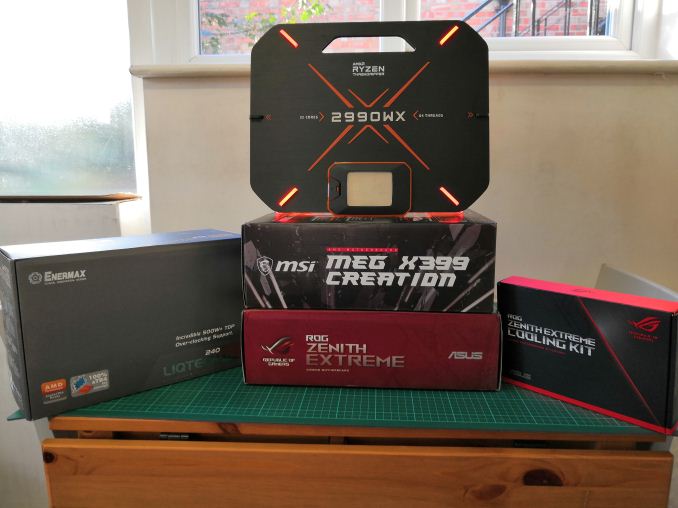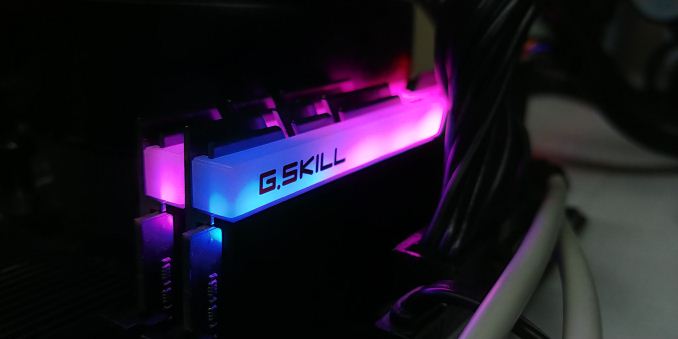The AMD Threadripper 2990WX 32-Core and 2950X 16-Core Review
by Dr. Ian Cutress on August 13, 2018 9:00 AM ESTTest Setup and Comparison Points
In our review kit from AMD, we were supplied with almost complete systems for testing. Inside the box of goods, AMD included:
- AMD Threadripper 2990WX (32C, 250W, $1799)
- AMD Threadripper 2950X (16C, 180W, $899)
- ASUS ROG Zenith Extreme motherboard, rev 2
- MSI X399 MEG Creation motherboard
- 4x8 GB of G.Skill FlareX DDR4-3200 14-14-14
- Wraith Ripper Cooler, co-developed with Cooler Master
- Enermax Liqtech 240 TR4 Liquid Cooler, rated to 500W
For our usual testing, we stick to the same power supplies, the same storage, ideally the same motherboard within a range of processors, and always use the latest BIOS. Despite AMD shipping us some reasonably fast memory, our standard policy is to test these systems at the maximum supported frequency as promoted by the processor manufacturer, or in this case DDR4-2933 for the new Threadripper 2000-series processors.
For our testing we compared the first generation Threadripper processors with the second generation parts. We also have the Intel 18-core Core i9-7980XE, some results from the Core i7-7900X (10-core), and also two mainstream processors, one Intel and one AMD. This is due to our new CPU testing suite, which takes effect today.
Due to an industry event occuring in the middle of our testing, we had to split some of the testing up and take 30 kg of kit half-way around the world to test in a hotel room during Flash Memory Summit. On the downside, it means there is some discontinuity in our testing, although not that much - on the plus side, the hardware tested in the hotel room had a good amount of air-conditioning to keep cool.
| AMD Test Setup | |||||
| CPUs | TR 2990WX | ASUS ROG Zenith | 0078 | Liqtech TR4 | 4x8GB DDR4-2933 |
| TR 2950X | ASUS ROG Zenith | 0078 | Liqtech TR4 | 4x8GB DDR4-2933 | |
| TR 1950X | ASUS X399-A Prime | 0806 | TRUE Cu | 4x4GB DDR4-2666 | |
| TR 1920X | ASUS ROG Zenith | 0078 | Liqtech TR4 | 4x8GB DDR4-2666 | |
| TR 1900X | ASUS X399-A Prime | 0806 | TRUE Cu | 4x4GB DDR4-2666 | |
| R7 2700X | ASUS Crosshair VI Hero | 0508 | Wraith Max | 4x8GB DDR4-2933 | |
| EPYC 7601 | GIGABYTE MZ31-AR0 | Fryzen | 8x128GB DDR4-2666 | ||
| GPU | Sapphire RX 460 2GB (CPU Tests) | ||||
| PSU | Corsair AX860i Corsair AX1200i |
||||
| SSD | Crucial MX300 1TB | ||||
| OS | Windows 10 x64 RS3 1709 Spectre and Meltdown Patched |
||||
The memory for our test suites was mostly G.Skill, with some Crucial. For the EPYC system, Micron sent us some LRDIMMs, so we fired up 1TB of memory to get all eight channels working.
On the Intel side, we are still getting up to speed on our testing.
| Intel Test Setup | |||||
| CPUs | i9-7980XE | ASRock X299 OC Formula | P1.40 | TRUE Cu | 4x8GB DDR4-2666 |
| i9-7900X | ASRock X299 OC Formula | P1.40 | TRUE Cu | 4x8GB DDR4-2666 | |
| i7-8700K | ASRock Z370 Gaming i7 | P1.70 | AR10-115XS | 4x4GB DDR4-2666 | |
| GPU | Sapphire RX 460 2GB (CPU Tests) | ||||
| PSU | Corsair AX860i Corsair AX1200i |
||||
| SSD | Crucial MX300 1TB | ||||
| OS | Windows 10 x64 RS3 1709 Spectre and Meltdown Patched |
||||
Over time we will be adding to our Intel CPUs tested.
Many thanks to...
We must thank the following companies for kindly providing hardware for our multiple test beds. Some of this hardware is not in this test bed specifically, but is used in other testing.
Thank you to Crucial for providing us with MX200 SSDs and to Micron for LRDIMMs. Crucial stepped up to the plate as our benchmark list grows larger with newer benchmarks and titles, and the 1TB MX200 units are strong performers. Based on Marvell's 88SS9189 controller and using Micron's 16nm 128Gbit MLC flash, these are 7mm high, 2.5-inch drives rated for 100K random read IOPs and 555/500 MB/s sequential read and write speeds. The 1TB models we are using here support TCG Opal 2.0 and IEEE-1667 (eDrive) encryption and have a 320TB rated endurance with a three-year warranty.
Further Reading: AnandTech's Crucial MX200 (250 GB, 500 GB & 1TB) Review
Thank you to Corsair for providing us with an AX1200i PSU. The AX1200i was the first power supply to offer digital control and management via Corsair's Link system, but under the hood it commands a 1200W rating at 50C with 80 PLUS Platinum certification. This allows for a minimum 89-92% efficiency at 115V and 90-94% at 230V. The AX1200i is completely modular, running the larger 200mm design, with a dual ball bearing 140mm fan to assist high-performance use. The AX1200i is designed to be a workhorse, with up to 8 PCIe connectors for suitable four-way GPU setups. The AX1200i also comes with a Zero RPM mode for the fan, which due to the design allows the fan to be switched off when the power supply is under 30% load.
Further Reading: AnandTech's Corsair AX1500i Power Supply Review
Thank you to G.Skill for providing us with memory. G.Skill has been a long-time supporter of AnandTech over the years, for testing beyond our CPU and motherboard memory reviews. We've reported on their high capacity and high-frequency kits, and every year at Computex G.Skill holds a world overclocking tournament with liquid nitrogen right on the show floor.
Further Reading: AnandTech's Memory Scaling on Haswell Review, with G.Skill DDR3-3000














171 Comments
View All Comments
NevynPA - Tuesday, August 14, 2018 - link
Will there be results for WX chips in 'Game Mode' at various core/thread counts (6/12,8/16,12/24)?jospoortvliet - Saturday, August 18, 2018 - link
It has no game mode. Don't bother buying it for games...jts888 - Tuesday, August 14, 2018 - link
What is the methodology used for the core/uncore power breakdown? Where was a physical measurement or software reading taken, and what were the loads used?Furthermore, Zen uses single-ended signaling for IF links with alleged even further reduced power draw when in transient no-send states, so there should be at least two clearly explained tests done (i.e., both high and low inter-thread/core/sock bandwidth, with NUMA allocations detailed) before interconnect power breakdowns can be credibly presented as flat metrics of the architectures investigated.
Although this review is still a work in progress, it needs some substantial improvements in clarity given the strength of the claims made and conclusions drawn.
ktmrc8 - Thursday, August 16, 2018 - link
Let me add my voice to those asking for further elaboration on this point. I think it's very interesting, but I would like enough detail so that I could possibly replicate your data. In particular, I the charts showing power consumption decreasing as number of loaded threads increase counter-intuitive (at least for me!). Thanks.Sahrin - Tuesday, August 14, 2018 - link
The link power is a problem, but I get the feeling that nowhere near the power optimization went into IF as went into the cores.notfeelingit - Tuesday, August 14, 2018 - link
What's up with the 2950X crazy low score for the PCMark10 Startup Test? Is that repeatable?crotach - Tuesday, August 14, 2018 - link
So, 2700X looks like a clear winner here?GreenReaper - Wednesday, August 15, 2018 - link
For the average consumer, yes. It's a sweet spot. Heck, most would do fine with an APU. You don't expect a truck to win a race. Small engines tend to be more efficient; they're just limited in raw power.witeko - Tuesday, August 14, 2018 - link
hi, can we have some tests regarding data processing (spark, dask), machine learning (lightGBM/xgboost training), deep learning (i know there are GPUs) just to get a feeling (there are pre-made benchmarks for tensorflow) ? And also some reviews point to win10 vs linux differences for example in the zip test.farmergann - Tuesday, August 14, 2018 - link
Really should have included the Epyc 7401p as it's a serious contender in this price range (only $1,000).